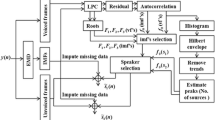Abstract
In order to solve the problems of noise interference in mobile phone microphone array, the traditional algorithms and blind source separation algorithms are compared and analyzed to enhance the mobile speech. Under the conditions of unknown mobile communication environment, the blind source separation algorithm is adopted to solve the problem. The mixed matrix is derived from the observed signal and the needed source signal is obtained by the inverse matrix. The separation effect is good and the intelligibility of the separated speech is high.
Access this chapter
Tax calculation will be finalised at checkout
Purchases are for personal use only
Similar content being viewed by others
References
Wan C (2017) Comparative study of typical near field beamforming methods for microphone arrays. Inner Mongolia University, Huhehaote (in Chinese)
Lei C (2016) Speech enhancement and realization of microphone array in noise background. Xiamen University, Xiamen (in Chinese)
Mao H (2005) Simulation and analysis of capon beamforming and spatial spectral algorithms based on Matlab 2(1):491–494 (in Chinese)
Zhang X (2016) Speech and audio coding, 2nd edn. Electronics Industry Press, Beijing (in Chinese)
Zhang X, Jia H (2011) Speech and audio coding. Xi’an University of Electronic Science and Technology Press, Xi’an (in Chinese)
Zhang Z (2011) Research and implementation of low-rate speech coding in single chip speech Cryptograph. Xi’an University of Electronic Science and Technology, Xi’an (in Chinese)
Cai Q, Liao Q, Jiang Z (2014) Research on signal processing of forming force based on wavelet transform and mean filter. Mach Tools Hydraulics 5:56–59 (in Chinese)
Zhong S (2014) Mathematical simulation experiment of double sliding window hysteresis algorithm for sinusoidal impulse signal. J Kunming Metall College 3:29–32 (in Chinese)
Huang H (2016) Detection of heart rate in motion state based on PPG signal. Southeast University, Nanjing (in Chinese)
Fu X (2015) Research on feedforward control of table active vibration isolation system based on LMS algorithm. University of Electronic Science and Technology, Chengdu (in Chinese)
Dong H (2016) Research on speech recognition based on spectral subtraction in noisy environment. Harbin Engineering University, Harbin (in Chinese)
Author information
Authors and Affiliations
Corresponding author
Editor information
Editors and Affiliations
Rights and permissions
Copyright information
© 2020 Springer Nature Switzerland AG
About this paper
Cite this paper
Wang, C., Wang, Q. (2020). Analysis and Research on Speech Enhancement Algorithms for Mobile Communication. In: Xu, Z., Choo, KK., Dehghantanha, A., Parizi, R., Hammoudeh, M. (eds) Cyber Security Intelligence and Analytics. CSIA 2019. Advances in Intelligent Systems and Computing, vol 928. Springer, Cham. https://doi.org/10.1007/978-3-030-15235-2_138
Download citation
DOI: https://doi.org/10.1007/978-3-030-15235-2_138
Published:
Publisher Name: Springer, Cham
Print ISBN: 978-3-030-15234-5
Online ISBN: 978-3-030-15235-2
eBook Packages: Intelligent Technologies and RoboticsIntelligent Technologies and Robotics (R0)




